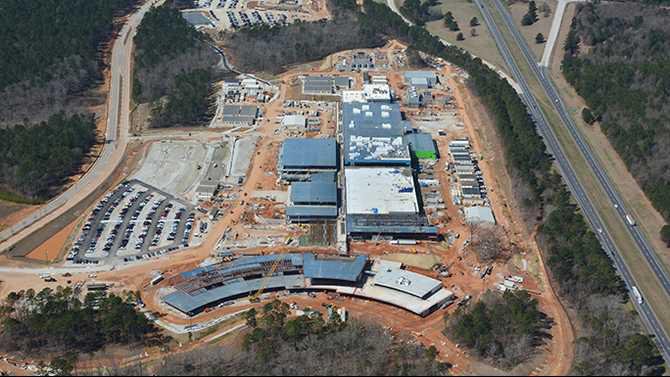The original version of this article contained a typo in the first sentence. Baxter's revenue for 2013 was more than $15 billion.
Baxter International’s Thursday announcement to split its business, which had more than $15 billion in revenue in 2013, into two companies in mid-2015 won’t have any effect on the construction of the $1 billion manufacturing campus being built just outside Social Circle. One thing that will change for sure is the plant’s name.
Baxter will split its $9.4 billion medical products division and its $5.8 billion BioScience division into separate businesses because of their diverging natures and potential for growth in both areas, company executives said Thursday.
The plant on the Newton/Walton county border, which will be producing plasma-based treatments Gammagard and Albumin by 2018, will fall under the BioScience company, which will be renamed at a later time. Baxter is known for its treatments for hemophilia, immune deficiencies, burns and other blood disorders, which will all fall under the BioScience side.
The medical products company will include anesthetics, injectable drugs, intravenous solutions and equipment to administer them, as well as biosurgery products, will retain the Baxter International name. Baxter acquired kidney dialysis product maker Gambro AB in 2012 for $4 billion.
Baxter spokeswoman Deborah Spak said in an email that all business operations would continue as usual until the split in mid-2015. She said the vast majority of employees and facilities are already under one business or the other.
“Construction of the Covington facility, which will produce BioScience products, is continuing according to plan,” Spak said.
Baxter CEO Bob Parkinson said he expects both companies to be global leaders, and he sees growth potential for both. He said allowing management to more effectively focus on each area moving forward will improve ability to market and sell products, improve innovation and focus on areas with the highest potential growth and increase revenue.
Both companies will remain headquartered in Deerfield, Ill.
Parkinson said Baxter has an established history of spinning off companies, including Allegiance Healthcare, a medical products company, Caremark, a pharmaceutical company, and Edwards Life Sciences, which develops products to treat cardiovascular disease.
In a conference call with investors, Parkinson said the decision wasn’t easy, but was the right one. He said Baxter had become more complex and the strategies for the two division had become increasingly divergent. While he admitted there’s risk in losing diversity in one business, Parkinson said the company’s executives felt there was more potential for growth both in the U.S. and in emerging international markets, particularly for BioScience, which only sees 15 percent of its sales in those markets now.
In its investor update document, Baxter predicted there would be a $50 billion market for medical products and a $65 billion market for biopharmaceuticals by 2017, with a big increase in the areas of hematology (blood diseases) and oncology (cancer). Baxter is aiming for an $11 billion share of that BioScience market, including making inroads into Brazil, China and Russia. The company estimates that 70 percent of patients with Hemophilia A – a disorder that delays blood clotting – are undiagnosed.
Parkinson said the BioScience business had a large number of existing products and several more in the development pipeline, adding to the company’s confidence in the spinoff.
Ludwig Hantson, president of Baxter’s BioScience business, will take over as CEO of the new company.
Covington’s plant will play a role in increasing the company’s production capacity, focusing on producing Gammagard and Albumin.
Gammagard is used to treat primary immune deficiency diseases. The most common types of primary immune deficiency diseases result in the inability to make antibodies, which help the body fight off infections from bacteria and viruses.
Gammagard is made from human plasma that has been given by healthy donors. Gammagard contains healthy antibodies collected from the donors to replace the missing antibodies in those with deficiencies.
Albumin is included in Baxter’s critical care therapies. Albumin is primarily used as replacement therapy as treatment for burns and blood deficiencies. Alubmin is an essential protein found in the plasma of a person’s blood. The protein is responsible for maintaining blood pressure and transporting fatty acids, hormones and enzymes.
Baxter purchased 162 acres in Stanton Springs Industrial Park off U.S. Highway 278, including 54 acres in Newton County and 108 acres in Walton County. Hantson told The News in April 2012 that only a third of the site will be built out for the initial $1 billion investment. The remaining 100-plus acres could be built out depending on company performance.
Baxter’s plans call for an integrated campus of buildings totaling one million square feet, including three main manufacturing buildings, as well as support components such as warehouse and utilities buildings, administrative facilities and laboratories.
According to moneymorning.com, an investing website, spinoffs are expected to be prominent in 2014, following several recent notable spinoffs. The website said spinoffs are sometimes used to unlock untapped potential for the new company and parent company or as a way to create shareholder value. Baxter’s shares went up following the announcement.






